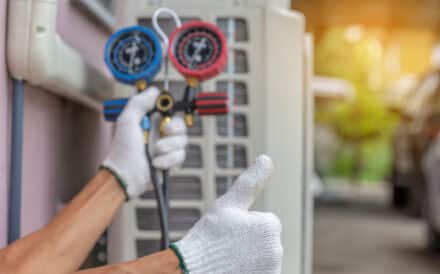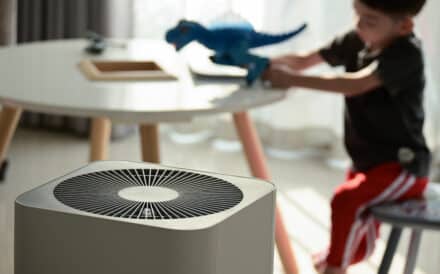DIY HVAC Care: What Homeowners Can Do to Complement Professional Maintenance
Your home’s HVAC system is like the heartbeat of your living space, circulating comfort through each room no matter what Mother Nature throws your way. While regular residential HVAC maintenance is a key piece of keeping your system healthy and functioning, you can do some simple DIY tasks between service visits to give your system the TLC it deserves.
The most important thing you can do to keep your system running smoothly is simple: Make twice-annual maintenance appointments! And between appointments, weaving simple DIY care into your routine while still relying on professional residential HVAC maintenance gives you the best of both worlds. You’ll enjoy a myriad of benefits, like better performance, longer system life, and lower monthly energy bills. From filter changes to your thermostat settings, these DIY-friendly tasks require no special tools or expertise, just a little time and attention that’ll pay off big time in the long run.
Five DIY HVAC Maintenance Tasks Anyone Can Do
1. Regularly Replace Air Filters
At the top of your residential HVAC maintenance checklist is one of the easiest yet most impactful tasks: regularly changing out your air filters. Filters play the important role of trapping and preventing allergens, dust, and other airborne particles from circulating through your home.
When your filter gets dirty or clogged, airflow becomes restricted, forcing your system to work harder and consume more energy than necessary. This means reduced efficiency, higher energy bills, and the potential for costly repairs or a premature breakdown if neglected.
Make it a habit to check your filters monthly and replace them every 1-3 months. If you have pets, allergies, or live in a dustier area, you’ll want to swap out your filter more often. Using high-efficiency filters? They might give you a little more time between changes, but they still deserve regular attention.
Pro tip: Write the date on the filter’s frame when you install it, so you’ll know exactly how long it’s been in use. Need a hand with the replacement? We can help!
2. Keep Your Outdoor Unit Clean and Clear
Your HVAC’s outdoor unit has a tough job—it sits outside year-round, dealing with whatever nature throws its way. Leaves, dirt, and debris tend to collect around it over time, blocking the airflow your system needs to run efficiently. As a part of your residential HVAC maintenance to-do list, be sure to clear away fallen leaves and outdoor debris from the area surrounding your unit. And when the winter weather hits, remember to gently clear away any snow or ice buildup that could keep your system from performing at its best.
3. Clean Vents and Registers
Like any surface in your home, vents and registers accumulate dust and debris over time. This buildup can gradually restrict airflow and negatively affect your indoor air quality. To ensure air circulates properly and to prevent dust from being blown back into your living spaces, periodically vacuum and wipe down registers and vents. This small residential HVAC maintenance task will help protect the clean, healthy air that you and your loved ones breathe every day.
4. Monitor and Program Your Thermostat
Don’t overlook your thermostat as a key player in your DIY residential HVAC maintenance routine. By strategically adjusting temperature settings—a few degrees higher in summer and lower in winter than you would normally prefer—you can reduce strain on your system as well as your energy usage. Smart and programmable thermostats take this efficiency to the next level, automatically managing temperature shifts based on your daily patterns.
Take a moment each month to ensure your thermostat is reading accurately and isn’t being affected by heat sources like direct sunlight, lamps, or electronics. While these thermostat adjustments can help optimize your unit’s day-to-day performance, they work best when paired with the thorough inspection and maintenance that professional techs provide.
5. Check for Leaks
When your HVAC system has a leak, you’ll feel it in both your comfort level and your wallet when your energy bill arrives. Grab a flashlight and inspect any visible ductwork for holes, tears, or loose connections where your treated air may be getting out before reaching your living spaces. It’s also worth checking windows and doors for drafts that make your system work harder than necessary.
Remember to occasionally examine the area around your indoor AC unit too. Water puddles can indicate refrigerant leaks or drainage issues that typically require a professional residential HVAC maintenance visit. Taking care of these small problems will help your system run more efficiently and avoid neglected issues snowballing into larger repairs.
Why You Need Professional Residential HVAC Maintenance
While these DIY tasks are important, you still need to schedule routine residential HVAC maintenance, ideally in the spring (before summer hits) and in the fall (before winter sets in). From inspecting electrician components and addressing leaks to lubricating parts and identifying small issues before they become expensive repairs, Silver State is here to help with expert residential HVAC maintenance services tailored to your system’s specific needs.
Contact us today to schedule your next maintenance visit so we can help you keep your HVAC system running at peak performance.




